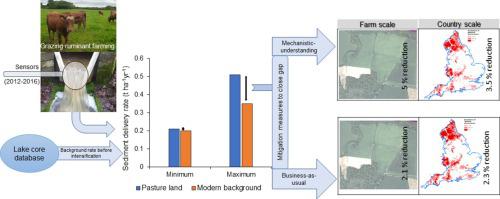当前位置:
X-MOL 学术
›
Environ. Sci. Policy
›
论文详情
Our official English website, www.x-mol.net, welcomes your
feedback! (Note: you will need to create a separate account there.)
Current advisory interventions for grazing ruminant farming cannot close exceedance of modern background sediment loss – Assessment using an instrumented farm platform and modelled scaling out
Environmental Science & Policy ( IF 4.9 ) Pub Date : 2021-02-01 , DOI: 10.1016/j.envsci.2020.11.004 A L Collins 1 , Y Zhang 1 , H R Upadhayay 1 , S Pulley 1 , S J Granger 1 , P Harris 1 , H Sint 1 , B Griffith 1
Environmental Science & Policy ( IF 4.9 ) Pub Date : 2021-02-01 , DOI: 10.1016/j.envsci.2020.11.004 A L Collins 1 , Y Zhang 1 , H R Upadhayay 1 , S Pulley 1 , S J Granger 1 , P Harris 1 , H Sint 1 , B Griffith 1
Affiliation

|
Abstract Water quality impairment by elevated sediment loss is a pervasive problem for global water resources. Sediment management targets identify exceedance or the sediment loss ‘gap’ requiring mitigation. In the UK, palaeo-limnological reconstruction of sediment loss during the 100–150 years pre-dating the post-World War II intensification of agriculture, has identified management targets (0.20−0.35 t ha−1 yr−1) representing ‘modern background sediment delivery to rivers’. To assess exceedance on land for grazing ruminant farming, an integrated approach combined new mechanistic evidence from a heavily-instrumented experimental farm platform and a scaling out framework of modelled commercial grazing ruminant farms in similar environmental settings. Monitoring (2012–2016) on the instrumented farm platform returned sediment loss ranges of 0.11−0.14 t ha−1 yr−1 and 0.21−0.25 t ha−1 yr-1 on permanent pasture, compared with between 0.19−0.23 t ha−1 yr-1 and 0.43−0.50 t ha−1 yr−1and 0.10−0.13 t ha−1 yr−1and 0.25−0.30 t ha−1 yr-1 on pasture with scheduled plough and reseeds. Excess sediment loss existed on all three farm platform treatments but was more extensive on the two treatments with scheduled plough and reseeds. Excessive sediment loss from land used by grazing ruminant farming more strategically across England, was estimated to be up to >0.2 t ha−1 yr−1. Modelled scenarios of alternative farming futures, based on either increased uptake of interventions typically recommended by visual farm audits, or interventions selected using new mechanistic understanding for sediment loss from the instrumented farm platform, returned minimum sediment loss reductions. On the farm platform these were 2.1 % (up to 0.007 t ha−1 yr−1) and 5.1 % (up to 0.018 t ha−1 yr-1). More strategically, these were up to 2.8 % (0.014 t ha−1 yr−1) and 4.1 % (0.023 t ha−1 yr−1). Conventional on-farm measures will therefore not fully mitigate the sediment loss gap, meaning that more severe land cover change is required.
中文翻译:

目前针对放牧反刍动物养殖的咨询干预措施无法弥补现代背景沉积物损失的超标——使用仪器化农场平台和模拟扩展进行评估
摘要 泥沙流失增加造成的水质损害是全球水资源面临的一个普遍问题。沉积物管理目标确定了需要缓解的超标或沉积物流失“差距”。在英国,对二战后农业集约化之前的 100-150 年期间沉积物流失的古湖泊学重建确定了代表“现代背景”的管理目标(0.20−0.35 t ha−1 yr−1)沉积物输送到河流。为了评估放牧反刍动物养殖用地的超标情况,采用了一种综合方法,结合了来自设备齐全的实验农场平台的新机械证据和类似环境环境中商业放牧反刍动物建模模型的扩展框架。仪器化农场平台的监测(2012-2016)返回泥沙流失范围为 0.11−0。永久牧场上的 14 t ha−1 yr−1 和 0.21−0.25 t ha−1 yr-1 相比,0.19−0.23 t ha−1 yr-1 和 0.43−0.50 t ha−1 yr−1 和 0.10−0.13 之间t ha−1 yr−1 和 0.25−0.30 t ha−1 yr-1 在牧场上,按计划犁耕和重新播种。所有三种农场平台处理都存在过量的沉积物损失,但在计划犁耕和重新播种的两种处理中损失更为广泛。据估计,英格兰各地更具战略性的放牧反刍动物养殖所使用的土地造成的沉积物过多流失量高达>0.2 t ha−1 yr−1。替代农业未来的模拟情景,基于增加视觉农场审计通常建议的干预措施的采用,或使用对仪表化农场平台沉积物流失的新机制理解而选择的干预措施,返回最小的沉积物损失减少。在农场平台上,这些比例为 2.1%(高达 0.007 t ha−1 yr−1)和 5.1%(高达 0.018 t ha−1 yr-1)。更具策略性的是,这些比例高达 2.8% (0.014 t ha−1 yr−1) 和 4.1% (0.023 t ha−1 yr−1)。因此,传统的农场措施无法完全缓解泥沙流失缺口,这意味着需要更严重的土地覆盖变化。
更新日期:2021-02-01
中文翻译:

目前针对放牧反刍动物养殖的咨询干预措施无法弥补现代背景沉积物损失的超标——使用仪器化农场平台和模拟扩展进行评估
摘要 泥沙流失增加造成的水质损害是全球水资源面临的一个普遍问题。沉积物管理目标确定了需要缓解的超标或沉积物流失“差距”。在英国,对二战后农业集约化之前的 100-150 年期间沉积物流失的古湖泊学重建确定了代表“现代背景”的管理目标(0.20−0.35 t ha−1 yr−1)沉积物输送到河流。为了评估放牧反刍动物养殖用地的超标情况,采用了一种综合方法,结合了来自设备齐全的实验农场平台的新机械证据和类似环境环境中商业放牧反刍动物建模模型的扩展框架。仪器化农场平台的监测(2012-2016)返回泥沙流失范围为 0.11−0。永久牧场上的 14 t ha−1 yr−1 和 0.21−0.25 t ha−1 yr-1 相比,0.19−0.23 t ha−1 yr-1 和 0.43−0.50 t ha−1 yr−1 和 0.10−0.13 之间t ha−1 yr−1 和 0.25−0.30 t ha−1 yr-1 在牧场上,按计划犁耕和重新播种。所有三种农场平台处理都存在过量的沉积物损失,但在计划犁耕和重新播种的两种处理中损失更为广泛。据估计,英格兰各地更具战略性的放牧反刍动物养殖所使用的土地造成的沉积物过多流失量高达>0.2 t ha−1 yr−1。替代农业未来的模拟情景,基于增加视觉农场审计通常建议的干预措施的采用,或使用对仪表化农场平台沉积物流失的新机制理解而选择的干预措施,返回最小的沉积物损失减少。在农场平台上,这些比例为 2.1%(高达 0.007 t ha−1 yr−1)和 5.1%(高达 0.018 t ha−1 yr-1)。更具策略性的是,这些比例高达 2.8% (0.014 t ha−1 yr−1) 和 4.1% (0.023 t ha−1 yr−1)。因此,传统的农场措施无法完全缓解泥沙流失缺口,这意味着需要更严重的土地覆盖变化。











































 京公网安备 11010802027423号
京公网安备 11010802027423号